Towards a Cultural Ontology for Interorganizational Knowledge Processes
人文学科是一个把美具象化的学科英语作文

人文学科是一个把美具象化的学科英语作文Humanities is a field of study that seeks to understand and interpret the beauty of human expression. It encompasses subjects such as literature, philosophy, history, art, music, and culture, all of which help to illuminate the complexities and nuances of human experience.One of the primary purposes of the humanities is to provide a space for the exploration and celebration of the human spirit. Through the study of literature, for example, we can delve into the minds and hearts of characters from various time periods and cultures, gaining insight into their hopes, dreams, fears, and struggles. By reading poetry, we can immerse ourselves in the rhythm and cadence of language, experiencing the power of words to evoke emotion and provoke thought. Through the study of art, we can appreciate the ways in which artists have captured and conveyed the beauty and pain of the human condition.The humanities also serve as a mirror, reflecting back to us our own beliefs, values, and prejudices. Through the study of history, we can learn about the triumphs and tragedies of humanity, gaining a greater understanding of the forces that have shaped our world. By engaging with philosophy, we canwrestle with fundamental questions about existence, morality, and the nature of reality, challenging and expanding our own perspectives.In essence, the humanities are a lens through which we can view and interpret the world around us. They provide us with the tools to analyze, critique, and appreciate the cultural artifacts that define and shape our society. By examining literature, art, music, and philosophy, we can gain a deeper appreciation for the diversity and richness of human experience.Ultimately, the humanities help us to cultivate empathy, curiosity, and critical thinking skills. They encourage us to engage with different ways of thinking and being, fostering a deeper appreciation for the complexity and beauty of the world. By studying the humanities, we can better understand ourselves and our place in the world, and develop a greater capacity for empathy and compassion.In conclusion, the humanities are a vital and essential field of study that offers us the opportunity to explore and celebrate the beauty of human expression. By studying literature, philosophy, history, art, music, and culture, we can gain a deeper appreciation for the diversity and complexity of human experience. The humanities provide us with the tools to analyze,critique, and appreciate the cultural artifacts that define and shape our society, and help us to cultivate empathy, curiosity, and critical thinking skills. In a world that is becoming increasingly polarized and divided, the humanities offer us a path towards greater understanding, connection, and compassion.。
对文化提炼的思考英语作文
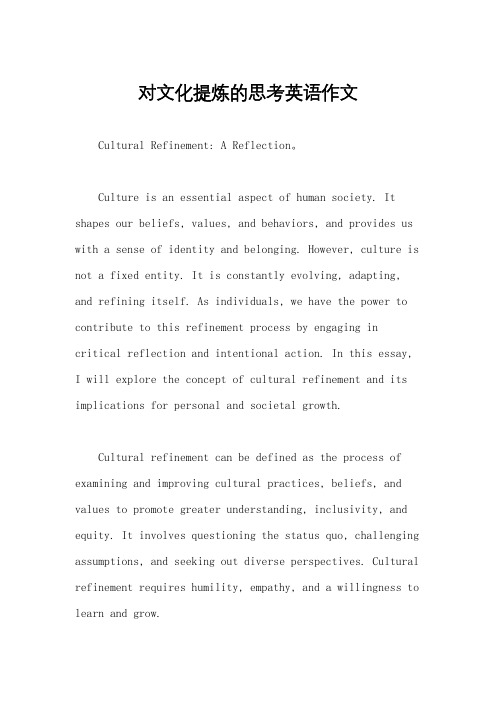
对文化提炼的思考英语作文Cultural Refinement: A Reflection。
Culture is an essential aspect of human society. It shapes our beliefs, values, and behaviors, and provides us with a sense of identity and belonging. However, culture is not a fixed entity. It is constantly evolving, adapting, and refining itself. As individuals, we have the power to contribute to this refinement process by engaging incritical reflection and intentional action. In this essay, I will explore the concept of cultural refinement and its implications for personal and societal growth.Cultural refinement can be defined as the process of examining and improving cultural practices, beliefs, and values to promote greater understanding, inclusivity, and equity. It involves questioning the status quo, challenging assumptions, and seeking out diverse perspectives. Cultural refinement requires humility, empathy, and a willingness to learn and grow.One of the key benefits of cultural refinement is increased awareness and understanding of different cultures. By engaging in critical reflection, we can identify our own biases and assumptions and work to overcome them. We can also seek out opportunities to learn about other cultures and perspectives, whether through travel, literature, or dialogue with people from different backgrounds. This increased awareness can lead to greater empathy and compassion, as we begin to see the world through the eyesof others.Cultural refinement also has practical implications for social justice and equity. By examining cultural practices and beliefs that perpetuate inequality and discrimination, we can work to dismantle these systems and promote greater inclusivity and fairness. For example, cultural refinement might involve challenging gender norms that limit opportunities for women, or examining the role of race and ethnicity in shaping social hierarchies.However, cultural refinement is not without itschallenges. It requires a willingness to be uncomfortable and to confront difficult truths. It also requires a recognition that cultural change is often slow and incremental, and that progress may be met with resistance. Nevertheless, the benefits of cultural refinement are well worth the effort.As individuals, we can contribute to cultural refinement in a variety of ways. We can engage in critical reflection on our own beliefs and behaviors, seek out diverse perspectives, and challenge injustice and inequality when we see it. We can also support cultural institutions that promote inclusivity and equity, such as museums, libraries, and community centers.At the societal level, cultural refinement requires a commitment to education, dialogue, and policy change. It requires leaders who are willing to listen to diverse perspectives and to take action to promote equity and justice. It also requires a recognition that cultural refinement is an ongoing process, and that there is always room for improvement.In conclusion, cultural refinement is a vital aspect of personal and societal growth. By engaging in critical reflection and intentional action, we can promote greater understanding, inclusivity, and equity. While the process of cultural refinement may be challenging, the benefits are well worth the effort. As individuals and as a society, we have the power to shape our culture and to create a more just and equitable world.。
对待文化差异的态度英语作文
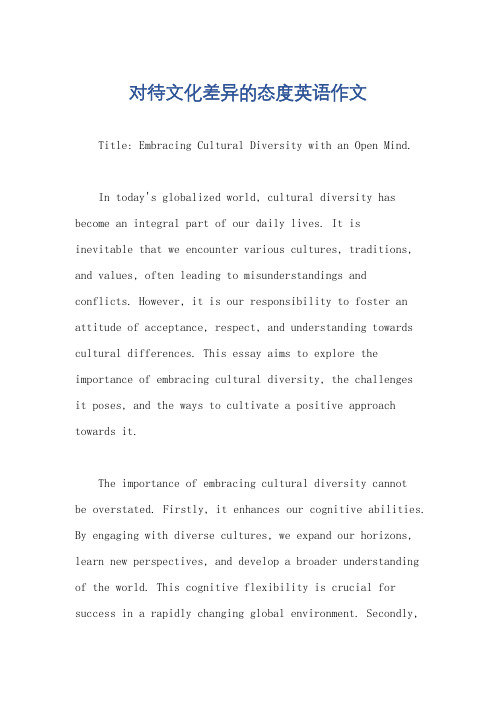
对待文化差异的态度英语作文Title: Embracing Cultural Diversity with an Open Mind.In today's globalized world, cultural diversity has become an integral part of our daily lives. It isinevitable that we encounter various cultures, traditions, and values, often leading to misunderstandings andconflicts. However, it is our responsibility to foster an attitude of acceptance, respect, and understanding towards cultural differences. This essay aims to explore the importance of embracing cultural diversity, the challengesit poses, and the ways to cultivate a positive approach towards it.The importance of embracing cultural diversity cannotbe overstated. Firstly, it enhances our cognitive abilities. By engaging with diverse cultures, we expand our horizons, learn new perspectives, and develop a broader understanding of the world. This cognitive flexibility is crucial for success in a rapidly changing global environment. Secondly,cultural diversity fosters innovation. Different cultures bring unique ideas, experiences, and solutions to problems, leading to the creation of new technologies, art forms, and social structures. Lastly, embracing cultural diversity is essential for building inclusive societies. It promotes mutual respect, reduces prejudice, and fosters a sense of belonging among diverse groups.However, embracing cultural diversity is not withoutits challenges. Language barriers can often hindereffective communication between people from different cultures. Cultural misunderstandings and stereotypes can lead to conflicts and misunderstandings. Additionally, differences in values and traditions.。
超实用高考英语复习:文学文化—新高考英语“中国元素”之书面表达
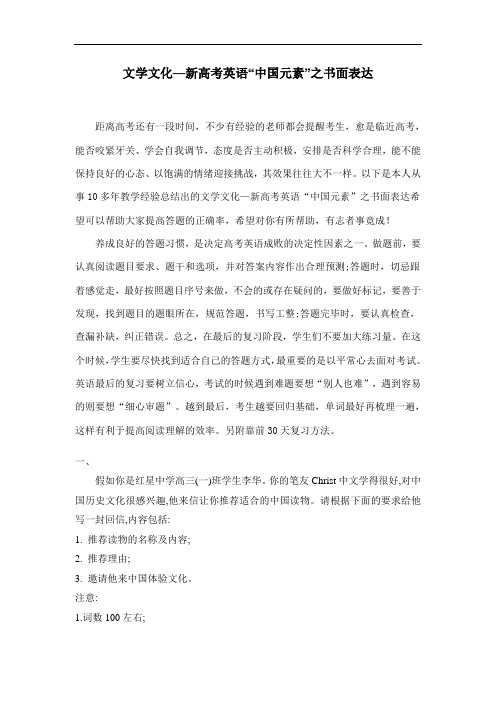
文学文化—新高考英语“中国元素”之书面表达距离高考还有一段时间,不少有经验的老师都会提醒考生,愈是临近高考,能否咬紧牙关、学会自我调节,态度是否主动积极,安排是否科学合理,能不能保持良好的心态、以饱满的情绪迎接挑战,其效果往往大不一样。
以下是本人从事10多年教学经验总结出的文学文化—新高考英语“中国元素”之书面表达希望可以帮助大家提高答题的正确率,希望对你有所帮助,有志者事竟成!养成良好的答题习惯,是决定高考英语成败的决定性因素之一。
做题前,要认真阅读题目要求、题干和选项,并对答案内容作出合理预测;答题时,切忌跟着感觉走,最好按照题目序号来做,不会的或存在疑问的,要做好标记,要善于发现,找到题目的题眼所在,规范答题,书写工整;答题完毕时,要认真检查,查漏补缺,纠正错误。
总之,在最后的复习阶段,学生们不要加大练习量。
在这个时候,学生要尽快找到适合自己的答题方式,最重要的是以平常心去面对考试。
英语最后的复习要树立信心,考试的时候遇到难题要想“别人也难”,遇到容易的则要想“细心审题”。
越到最后,考生越要回归基础,单词最好再梳理一遍,这样有利于提高阅读理解的效率。
另附靠前30天复习方法。
一、假如你是红星中学高三(一)班学生李华。
你的笔友Christ中文学得很好,对中国历史文化很感兴趣,他来信让你推荐适合的中国读物。
请根据下面的要求给他写一封回信,内容包括:1. 推荐读物的名称及内容;2. 推荐理由;3. 邀请他来中国体验文化。
注意:1.词数100左右;2.开头和结尾己给出,不计入总词数。
Dear Christ,_____________________________________________________________________ _____________________________________________________________________ _____________________________________________________________________ _____________________________________________________________________ _____________________________________________________________________ _____________________________________________________________________ 二、假定你是李华,你校将举办“中国古典名著研讨会”活动。
对待文化多样性英语作文
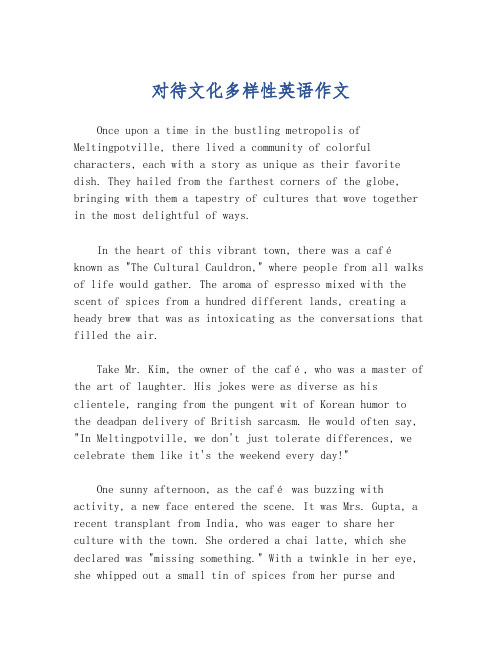
对待文化多样性英语作文Once upon a time in the bustling metropolis of Meltingpotville, there lived a community of colorful characters, each with a story as unique as their favorite dish. They hailed from the farthest corners of the globe, bringing with them a tapestry of cultures that wove together in the most delightful of ways.In the heart of this vibrant town, there was a café known as "The Cultural Cauldron," where people from all walks of life would gather. The aroma of espresso mixed with the scent of spices from a hundred different lands, creating a heady brew that was as intoxicating as the conversations that filled the air.Take Mr. Kim, the owner of the café, who was a master of the art of laughter. His jokes were as diverse as his clientele, ranging from the pungent wit of Korean humor to the deadpan delivery of British sarcasm. He would often say, "In Meltingpotville, we don't just tolerate differences, we celebrate them like it's the weekend every day!"One sunny afternoon, as the café was buzzing w ith activity, a new face entered the scene. It was Mrs. Gupta, a recent transplant from India, who was eager to share her culture with the town. She ordered a chai latte, which she declared was "missing something." With a twinkle in her eye, she whipped out a small tin of spices from her purse andsprinkled it into her drink. The aroma that followed was like a magic carpet ride through the markets of Delhi.As the days turned into weeks, Mrs. Gupta became a regular, and her chai latte became a sensation. People from all over town would flock to "The Cultural Cauldron" to try this new twist on an old favorite. Mr. Kim, never one to miss an opportunity for a good pun, would joke, "We've got the recipe for world peace right here: a pinch of this, a dash of that, and a whole lot of understanding!"The café soon became a hub for cultural exchange. There was Senorita Rodriguez, who taught everyone the art of the salsa, and Old Man Svensson, who regaled the patrons with tales of the Northern Lights. Each story, each recipe, each dance step was a new thread in the tapestry of Meltingpotville.But the true magic of the town was not just in the sharing of food and stories. It was in the way the people listened, learned, and laughed together. They embraced their differences, recognizing that each culture brought a unique flavor to the community. They understood that diversity was not a challenge to be overcome, but a treasure to be cherished.And so, the people of Meltingpotville continued to livein harmony, proving that when it comes to culture, the more the merrier. They danced to the beat of a thousand drums, sang in a chorus of a thousand voices, and laughed at the punchlines of a thousand jokes. In this town, diversity wasnot just accepted; it was the spice of life, the secret ingredient that made every day a feast to be savored.As the sun set on another day in Meltingpotville, the laughter from "The Cultural Cauldron" echoed through the streets, a testament to the joy that comes from embracing our differences. And as the stars began to twinkle in the night sky, each one a distant light in the vast universe, the people of the town knew that they were part of something bigger, something beautiful, and something uniquely human.In the end, the story of Meltingpotville is a simple one: a tale of how a town full of different people, with different customs and cuisines, found that the key to unity was as close as their next door neighbor, their local café, and the shared love for a good joke and a better cup of coffee.。
北师大英语必修二第四单元考试作文
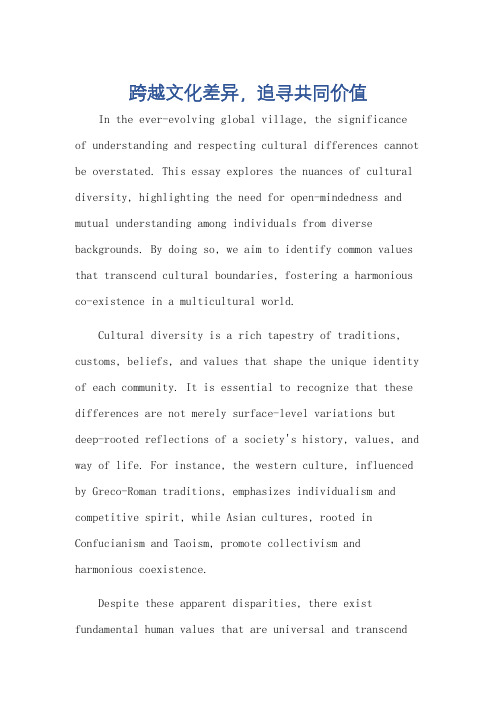
跨越文化差异,追寻共同价值In the ever-evolving global village, the significance of understanding and respecting cultural differences cannot be overstated. This essay explores the nuances of cultural diversity, highlighting the need for open-mindedness and mutual understanding among individuals from diverse backgrounds. By doing so, we aim to identify common values that transcend cultural boundaries, fostering a harmonious co-existence in a multicultural world.Cultural diversity is a rich tapestry of traditions, customs, beliefs, and values that shape the unique identity of each community. It is essential to recognize that these differences are not merely surface-level variations but deep-rooted reflections of a society's history, values, and way of life. For instance, the western culture, influenced by Greco-Roman traditions, emphasizes individualism and competitive spirit, while Asian cultures, rooted in Confucianism and Taoism, promote collectivism and harmonious coexistence.Despite these apparent disparities, there exist fundamental human values that are universal and transcendcultural divides. The quest for knowledge, the desire for peace and happiness, the importance of family and community – these are aspirations shared by people across the globe. It is our responsibility to identify and nurture these shared values, creating bridges of understanding andrespect between different cultures.In today's interconnected world, the need for cross-cultural understanding is paramount. With the advent of technology and globalization, people from diverse cultures are increasingly interacting and collaborating. It iscrucial that we learn to appreciate and accommodate these differences, rather than view them as barriers. By doing so, we can contribute to the creation of a more inclusive and harmonious society where people from different cultures can coexist peacefully and prosper together.In conclusion, cultural diversity is a beautiful and enriching aspect of human civilization. By embracing our differences and searching for common values, we can build bridges of understanding and respect that lead to a more unified and prosperous world. Let us strive to create aglobal community that celebrates our unique identitieswhile also nurturing our shared aspirations.**跨越文化差异,追寻共同价值**在全球化日益发展的今天,理解和尊重文化差异的重要性不言而喻。
从文化角度看英语作文
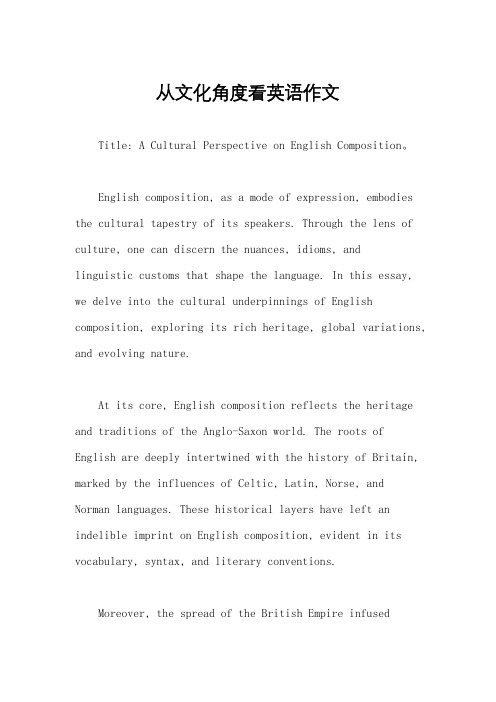
从文化角度看英语作文Title: A Cultural Perspective on English Composition。
English composition, as a mode of expression, embodies the cultural tapestry of its speakers. Through the lens of culture, one can discern the nuances, idioms, andlinguistic customs that shape the language. In this essay, we delve into the cultural underpinnings of English composition, exploring its rich heritage, global variations, and evolving nature.At its core, English composition reflects the heritage and traditions of the Anglo-Saxon world. The roots of English are deeply intertwined with the history of Britain, marked by the influences of Celtic, Latin, Norse, and Norman languages. These historical layers have left an indelible imprint on English composition, evident in its vocabulary, syntax, and literary conventions.Moreover, the spread of the British Empire infusedEnglish with diverse cultural influences from around the globe. Colonization brought English to distant shores, where it assimilated local dialects and enriched its lexicon with borrowings from languages such as Hindi, Arabic, and Swahili. This linguistic amalgamation reflects the dynamic nature of English composition, which continues to evolve through contact with other cultures.In the United States, English composition takes on a distinct character shaped by the nation's multicultural society. The melting pot of American culture has contributed to the emergence of unique linguistic features, from regional dialects like Southern drawl to urban slang like "yo" and "dude." Moreover, African American Vernacular English (AAVE) has exerted a profound influence on American English, permeating popular culture and reshapinglinguistic norms.Similarly, in countries like India, Nigeria, and Singapore, English composition reflects the intersection of local languages and colonial legacies. These post-colonial societies have forged their own varieties of English,imbued with indigenous expressions, syntax, and cultural references. For instance, Indian English is characterized by its use of Indian idioms, such as "chai" for tea and "bungalow" for a single-story house, reflecting thecultural fusion of East and West.Furthermore, English composition serves as a medium for cultural expression and identity. Writers across the globe use English to articulate their unique perspectives, narratives, and experiences. From Chinua Achebe's portrayal of Igbo culture in "Things Fall Apart" to Jhumpa Lahiri's exploration of the immigrant experience in "The Namesake," literature written in English offers a window into diverse cultures and worldviews.In the realm of English composition, cultural awareness is paramount. Effective communication requires an understanding of the cultural contexts that shape language use and interpretation. As such, language learners are encouraged to not only master grammar and vocabulary but also to appreciate the cultural nuances embedded within the language.In conclusion, English composition is a reflection of cultural diversity, heritage, and creativity. From its origins in medieval England to its global spread in the modern era, English has evolved into a dynamic andinclusive language that embraces a multitude of voices and perspectives. By embracing the cultural richness of English, we can truly appreciate its power to connect people across borders and bridge cultural divides.By intertwining the intricacies of English composition with cultural insights, one can craft compositions that resonate with depth and authenticity. As we navigate the complexities of language and culture, let us celebrate the richness and diversity that make English composition atruly global phenomenon.。
对待文化多样性的正确态度英语作文
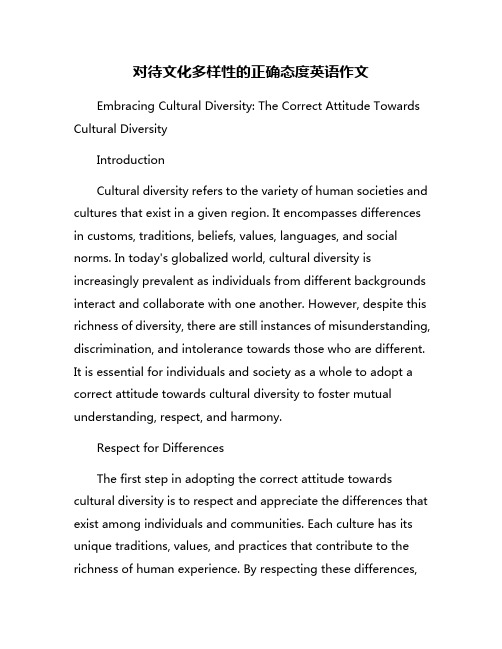
对待文化多样性的正确态度英语作文Embracing Cultural Diversity: The Correct Attitude Towards Cultural DiversityIntroductionCultural diversity refers to the variety of human societies and cultures that exist in a given region. It encompasses differences in customs, traditions, beliefs, values, languages, and social norms. In today's globalized world, cultural diversity is increasingly prevalent as individuals from different backgrounds interact and collaborate with one another. However, despite this richness of diversity, there are still instances of misunderstanding, discrimination, and intolerance towards those who are different. It is essential for individuals and society as a whole to adopt a correct attitude towards cultural diversity to foster mutual understanding, respect, and harmony.Respect for DifferencesThe first step in adopting the correct attitude towards cultural diversity is to respect and appreciate the differences that exist among individuals and communities. Each culture has its unique traditions, values, and practices that contribute to the richness of human experience. By respecting these differences,we can learn from one another and gain a deeper understanding of our shared humanity. It is important to approach cultural diversity with an open mind and a willingness to listen and learn from others.Avoiding StereotypesStereotyping is a common pitfall when it comes to cultural diversity. It involves making assumptions about individuals or groups based on their cultural background, which can lead to prejudice and discrimination. It is essential to recognize that no culture is monolithic, and individuals within a culture may have diverse beliefs and experiences. By avoiding stereotypes and treating each person as an individual, we can foster a more inclusive and respectful society.Celebrating DiversityAnother important aspect of adopting the correct attitude towards cultural diversity is celebrating the diversity of cultures and promoting inclusion and equality. Cultural diversity brings vibrancy, creativity, and innovation to society. By embracing cultural differences and promoting cultural exchanges, we can create a more inclusive and harmonious world. It is essential to support initiatives that promote diversity, such as multiculturalfestivals, intercultural dialogues, and educational programs that celebrate different cultures.Promoting Cultural AwarenessCultural awareness is key to fostering mutual understanding and respect among individuals from different backgrounds. By educating ourselves about different cultures, traditions, and histories, we can develop empathy and appreciation for the diversity of human experience. It is important to engage in cross-cultural communication, learn from diverse perspectives, and challenge our biases and assumptions. By promoting cultural awareness, we can build bridges between individuals and communities and create a more inclusive society.Resisting Discrimination and PrejudiceOne of the most critical aspects of adopting the correct attitude towards cultural diversity is standing up against discrimination and prejudice. Discrimination based on race, ethnicity, religion, or nationality is a violation of human rights and undermines social cohesion. It is essential to speak out against discriminatory attitudes and behaviors, promote equality and inclusion, and support marginalized communities. By actively resisting discrimination and prejudice, we can create a more just and equitable society for all.ConclusionIn conclusion, adopting the correct attitude towards cultural diversity is essential in today's diverse and interconnected world. By respecting differences, avoiding stereotypes, celebrating diversity, promoting cultural awareness, and resisting discrimination and prejudice, individuals and society can foster mutual understanding, respect, and harmony. Embracing cultural diversity enriches our lives, broadens our perspectives, and strengthens our communities. Let us embrace diversity and build a more inclusive and peaceful world for future generations.。
对待中西方文化差异时最明智的方法英语作文

对待中西方文化差异时最明智的方法英语作文Navigating the Nuances: The Wisest Approach to Cultural Differences between East and WestThe world we inhabit is a tapestry of diverse cultures, each with its own unique traditions, beliefs, and ways of life. As globalization continues to shrink the distance between the East and the West, the need to understand and appreciate these cultural differences has become increasingly paramount. Adopting the wisest approach to navigating these differences is essential for fostering mutual understanding, respect, and harmony.One of the fundamental aspects of this approach is the willingness to embrace cultural relativism. Rather than judging other cultures through the lens of our own cultural biases, we must strive to understand and appreciate the context in which these differences arise. Every culture has its own historical, social, and philosophical underpinnings that shape its values and practices. By suspending our preconceptions and actively seeking to comprehend the rationale behind these differences, we can gain a deeper and more nuancedunderstanding of the world around us.This open-mindedness extends to the recognition that there is no inherent superiority or inferiority in cultural traditions. Each culture has its own unique strengths and contributions to offer, and the wisest approach is to acknowledge and appreciate these differences without imposing our own standards of what is "right" or "wrong." This mindset allows us to engage in cross-cultural dialogue and exchange, where we can learn from one another and find common ground, rather than engaging in a futile attempt to enforce cultural homogeneity.At the same time, the wisest approach to cultural differences also requires a delicate balance between cultural relativism and the recognition of universal human rights and values. While we must be respectful of cultural diversity, there are certain fundamental principles, such as human dignity, equality, and the protection of vulnerable populations, that transcend cultural boundaries. In situations where cultural practices violate these universal norms, it is essential to engage in constructive dialogue and work towards finding solutions that respect both cultural traditions and human rights.This nuanced understanding of cultural differences also extends to the realm of communication and interpersonal interactions. Effectivecross-cultural communication requires an awareness of the subtle differences in verbal and non-verbal cues, as well as the underlying cultural assumptions that shape our modes of expression. By developing cultural intelligence and adaptability, we can navigate these differences with sensitivity and grace, fostering more meaningful and productive exchanges.Moreover, the wisest approach to cultural differences recognizes the inherent value in diversity and the richness it brings to our shared human experience. Rather than viewing cultural differences as a source of conflict or division, we can celebrate them as opportunities for growth, learning, and the expansion of our own perspectives. By embracing the diversity of the human experience, we can cultivate a more inclusive, empathetic, and interconnected world.In conclusion, the wisest approach to navigating the cultural differences between the East and the West lies in a multifaceted approach that combines cultural relativism, respect for universal human values, effective cross-cultural communication, and an appreciation for the inherent value of diversity. By adopting this mindset, we can foster greater understanding, cooperation, and harmony in an increasingly interconnected world. It is through this lens that we can truly harness the transformative power of cultural exchange and build a more just, equitable, and vibrant global community.。
对文化交流的看法英语作文
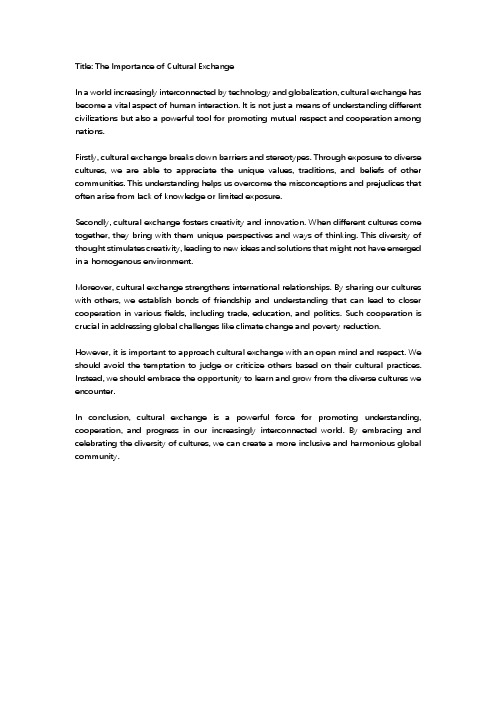
Title: The Importance of Cultural ExchangeIn a world increasingly interconnected by technology and globalization, cultural exchange has become a vital aspect of human interaction. It is not just a means of understanding different civilizations but also a powerful tool for promoting mutual respect and cooperation among nations.Firstly, cultural exchange breaks down barriers and stereotypes. Through exposure to diverse cultures, we are able to appreciate the unique values, traditions, and beliefs of other communities. This understanding helps us overcome the misconceptions and prejudices that often arise from lack of knowledge or limited exposure.Secondly, cultural exchange fosters creativity and innovation. When different cultures come together, they bring with them unique perspectives and ways of thinking. This diversity of thought stimulates creativity, leading to new ideas and solutions that might not have emerged in a homogenous environment.Moreover, cultural exchange strengthens international relationships. By sharing our cultures with others, we establish bonds of friendship and understanding that can lead to closer cooperation in various fields, including trade, education, and politics. Such cooperation is crucial in addressing global challenges like climate change and poverty reduction.However, it is important to approach cultural exchange with an open mind and respect. We should avoid the temptation to judge or criticize others based on their cultural practices. Instead, we should embrace the opportunity to learn and grow from the diverse cultures we encounter.In conclusion, cultural exchange is a powerful force for promoting understanding, cooperation, and progress in our increasingly interconnected world. By embracing and celebrating the diversity of cultures, we can create a more inclusive and harmonious global community.。
对待中西文化的态度的英语作文
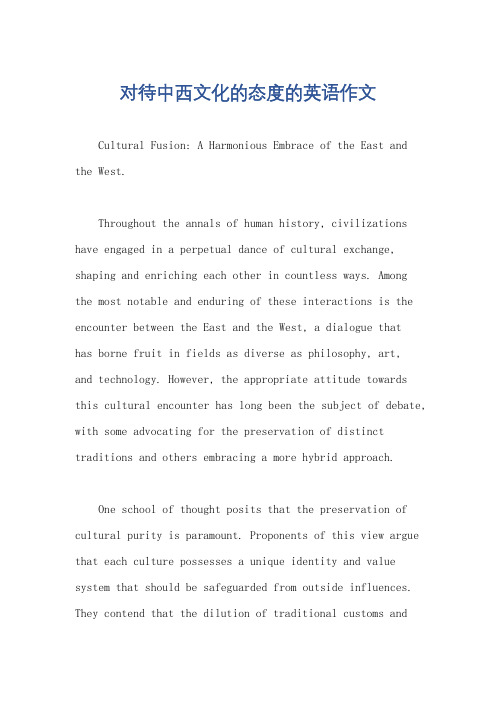
对待中西文化的态度的英语作文Cultural Fusion: A Harmonious Embrace of the East and the West.Throughout the annals of human history, civilizations have engaged in a perpetual dance of cultural exchange, shaping and enriching each other in countless ways. Among the most notable and enduring of these interactions is the encounter between the East and the West, a dialogue thathas borne fruit in fields as diverse as philosophy, art,and technology. However, the appropriate attitude towards this cultural encounter has long been the subject of debate, with some advocating for the preservation of distinct traditions and others embracing a more hybrid approach.One school of thought posits that the preservation of cultural purity is paramount. Proponents of this view argue that each culture possesses a unique identity and value system that should be safeguarded from outside influences. They contend that the dilution of traditional customs andbeliefs compromises the integrity of a society and undermines its sense of self. In this perspective, cultural exchange is seen as a threat to the preservation ofcultural heritage.However, an alternative perspective embraces the notion of cultural fusion, viewing the blending of East and West not as a threat but as an opportunity for growth and enrichment. Advocates of this approach maintain that cultures are dynamic and ever-evolving, constantly adapting and absorbing new ideas and influences. They argue that intercultural dialogue fosters creativity, innovation, and a more nuanced understanding of the human condition.The history of human civilization provides ample evidence to support the benefits of cultural fusion. The Silk Road, a vast network of trade routes connecting East and West, facilitated the exchange of goods, ideas, and technologies that transformed both regions. The rise of the Islamic Golden Age, a period of unprecedented scientific and cultural advancement, was in no small part due to the synthesis of Greek, Persian, and Indian influences. In themodern era, the global spread of ideas and technologies has led to a cross-pollination of cultures, resulting in new forms of art, music, and cuisine.Moreover, the embrace of cultural fusion can promote mutual understanding and tolerance. By engaging with different perspectives and worldviews, individuals gain a broader appreciation for the diversity of human experience. This understanding fosters empathy, reduces prejudice, and contributes to a more harmonious and just society.Of course, cultural fusion should not be pursued at the expense of cultural identity. It is essential to strike a balance between preserving one's own traditions and embracing the influences of others. This can be achieved through selective adoption, where elements of foreign cultures are incorporated without compromising the core values and beliefs of one's own society.Furthermore, it is important to approach intercultural dialogue with respect and humility. Cultural exchange should not be a one-way street, with one culture dominatingor imposing itself over another. Rather, it should be a process of mutual learning and growth, where both parties recognize the value and validity of each other's traditions.In conclusion, the appropriate attitude towards the encounter between East and West is not one of preservationor assimilation, but rather of harmonious fusion. By embracing the benefits of cultural exchange whilerespecting the integrity of each tradition, we can create a world that is both diverse and united, where the wisdom and creativity of all cultures can flourish and contribute tothe betterment of humanity.In the words of the acclaimed author Salman Rushdie, "The world is not simply a collection of clearly defined spaces, but an intermingling of cultures and histories that together form a constantly evolving mosaic. It is throughthe embrace of this interconnectedness that we truly discover our own place within the grand tapestry of human existence."。
对待传统文化的扰度英语作文

对待传统文化的扰度英语作文When it comes to the treatment of traditional culture, there are a few different perspectives that people might have. Some may value traditional culture and believe that it should be preserved and celebrated, while others may see it as outdated and irrelevant to modern society. In my opinion, traditional culture should be respected and appreciated, but it should also be open to adaptation and evolution in order to remain relevant in today's world.Traditional culture is an important part of our history and identity, and it can offer valuable insights into the customs, beliefs, and practices of our ancestors. It provides a sense of continuity and connection to the past, and it can also be a source of inspiration and creativity. For these reasons, it is important to preserve and protect traditional culture from being lost or forgotten.However, it is also important to recognize that traditional culture is not static. It has always evolved and adapted to changing circumstances, and it should continue to do so in order to remain meaningful to contemporary society. This means that we should not beafraid to reinterpret or update traditional practices in ways that are relevant to our lives today. For example, traditional art forms can be infused with modern techniques and themes, and traditional rituals can be adapted to reflect contemporary values and beliefs.Furthermore, it is important to acknowledge that traditional culture is not monolithic. It is diverse and multifaceted, and different communities may have their own unique traditions and customs. Therefore, it is important to approach traditional culture with an open mind and a willingness to learn from different perspectives. This can help to foster a greater appreciation for the richness and diversity of traditional culture, and it can also help to ensure that it remains a living and dynamic part of our society.In conclusion, traditional culture should be treated with respect and appreciation, but it should also be open to adaptation and evolution. By preserving and protecting traditional culture while also allowing it to evolve, we can ensure that it remains relevant and meaningful in our lives today.对待传统文化,人们可能会有不同的观点。
年轻人对传统文化的态度英语作文
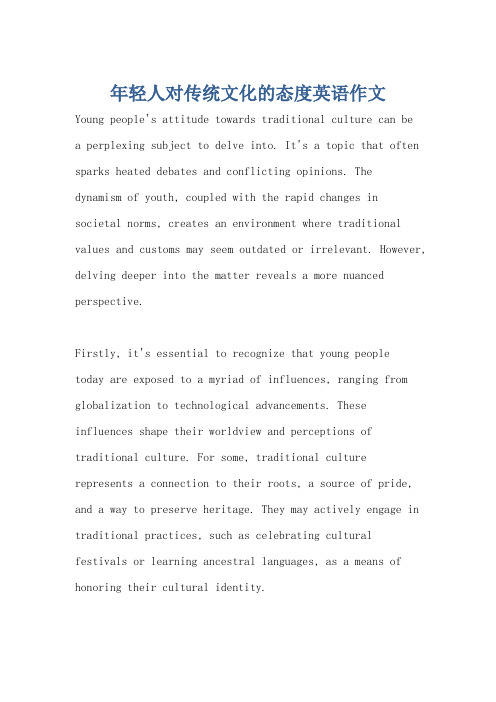
年轻人对传统文化的态度英语作文Young people's attitude towards traditional culture can bea perplexing subject to delve into. It's a topic that often sparks heated debates and conflicting opinions. The dynamism of youth, coupled with the rapid changes insocietal norms, creates an environment where traditional values and customs may seem outdated or irrelevant. However, delving deeper into the matter reveals a more nuanced perspective.Firstly, it's essential to recognize that young peopletoday are exposed to a myriad of influences, ranging from globalization to technological advancements. Theseinfluences shape their worldview and perceptions of traditional culture. For some, traditional culture represents a connection to their roots, a source of pride, and a way to preserve heritage. They may actively engage in traditional practices, such as celebrating culturalfestivals or learning ancestral languages, as a means of honoring their cultural identity.Conversely, there exists a segment of young individuals who view traditional culture through a lens of skepticism or indifference. To them, traditional values may seem archaic or incompatible with modern principles of equality and progress. This group may prioritize individualism and innovation over conformity to age-old customs. Their attitude towards traditional culture may be one of detachment, viewing it as something belonging to a bygone era rather than relevant to contemporary life.However, it's essential to avoid oversimplifying the complexities of young people's attitudes towardstraditional culture. Many fall somewhere in between these two extremes, navigating a delicate balance between embracing modernity and cherishing tradition. They may selectively adopt aspects of traditional culture that resonate with them while discarding those perceived as restrictive or outdated.Moreover, the resurgence of interest in traditional culture among young people can be observed in various forms. From the popularity of traditional crafts such as pottery andcalligraphy to the revival of ancient martial arts practices like Tai Chi and Kendo, there's a palpable interest in reconnecting with the past. This revival is not merely a nostalgic longing for a romanticized version of the past but rather a conscious effort to rediscover and reinterpret traditional values in a contemporary context.In essence, young people's attitude towards traditional culture is a multifaceted phenomenon influenced by a multitude of factors. It's not a simple dichotomy of acceptance or rejection but rather a spectrum of perspectives shaped by individual experiences, societal dynamics, and cultural influences. As society continues to evolve, so too will the relationship between the younger generation and their heritage, reflecting the ever-changing nature of human identity and cultural evolution.。
文化方向的英语作文
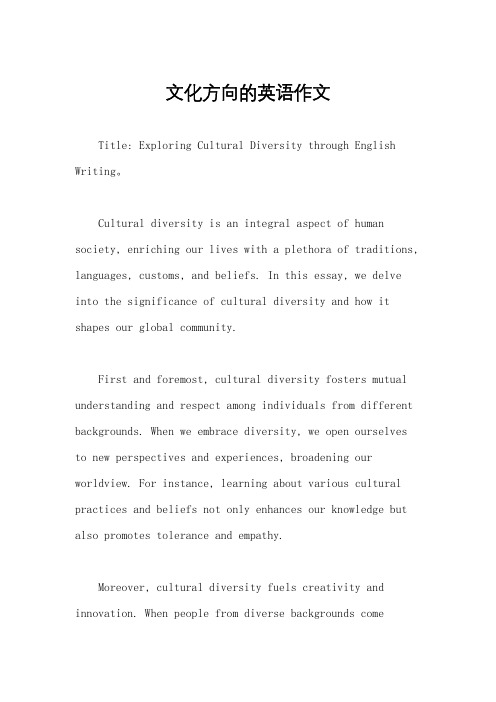
文化方向的英语作文Title: Exploring Cultural Diversity through English Writing。
Cultural diversity is an integral aspect of human society, enriching our lives with a plethora of traditions, languages, customs, and beliefs. In this essay, we delve into the significance of cultural diversity and how it shapes our global community.First and foremost, cultural diversity fosters mutual understanding and respect among individuals from different backgrounds. When we embrace diversity, we open ourselves to new perspectives and experiences, broadening our worldview. For instance, learning about various cultural practices and beliefs not only enhances our knowledge but also promotes tolerance and empathy.Moreover, cultural diversity fuels creativity and innovation. When people from diverse backgrounds cometogether, they bring unique ideas and insights to the table. This amalgamation of perspectives often leads to groundbreaking solutions to complex problems. Take, for example, the field of technology, where diverse teams are known to produce more innovative and inclusive products and services.Furthermore, cultural diversity plays a vital role in preserving heritage and tradition. Each culture contributes its own rich tapestry of art, music, literature, cuisine, and rituals, which serve as a testament to human creativity and ingenuity. By celebrating and preserving these cultural treasures, we ensure that future generations inherit a vibrant and diverse world.However, despite its numerous benefits, cultural diversity also presents challenges such as prejudice, discrimination, and cultural clashes. It is essential to address these issues through education, dialogue, and fostering intercultural communication. By promoting mutual respect and understanding, we can build bridges across cultural divides and create a more inclusive society.In the realm of language, English serves as a global lingua franca, facilitating communication among people of different cultural backgrounds. As a result, Englishwriting becomes a powerful tool for expressing cultural identity, sharing perspectives, and bridging cultural gaps. Through English writing, individuals can convey their unique experiences, traditions, and values to a global audience, fostering cross-cultural dialogue and appreciation.Moreover, English writing allows us to explore and understand cultures beyond our own, providing a window into the diverse tapestry of humanity. Through literature, essays, and other forms of written expression, we can immerse ourselves in different cultures, gaining insights into their history, values, and worldview. This fosters empathy and solidarity, breaking down barriers andfostering a sense of global citizenship.In conclusion, cultural diversity is a cornerstone of our shared humanity, enriching our lives in myriad ways.Through English writing, we can celebrate and explore the richness of cultural diversity, fostering understanding, empathy, and mutual respect across borders. As we navigate an increasingly interconnected world, embracing cultural diversity is not only a moral imperative but also a source of strength and inspiration for generations to come.。
推动传统中国文化的方式英语作文
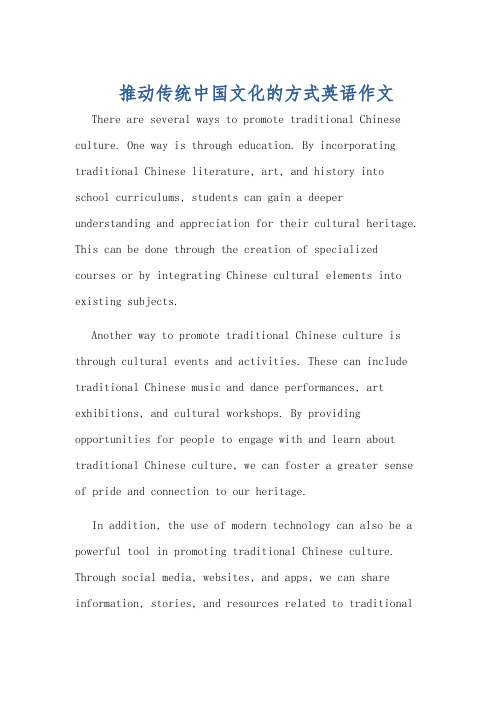
推动传统中国文化的方式英语作文There are several ways to promote traditional Chinese culture. One way is through education. By incorporating traditional Chinese literature, art, and history into school curriculums, students can gain a deeper understanding and appreciation for their cultural heritage. This can be done through the creation of specialized courses or by integrating Chinese cultural elements into existing subjects.Another way to promote traditional Chinese culture is through cultural events and activities. These can include traditional Chinese music and dance performances, art exhibitions, and cultural workshops. By providing opportunities for people to engage with and learn about traditional Chinese culture, we can foster a greater sense of pride and connection to our heritage.In addition, the use of modern technology can also be a powerful tool in promoting traditional Chinese culture. Through social media, websites, and apps, we can share information, stories, and resources related to traditionalChinese culture with a global audience. This can help to increase awareness and interest in our cultural traditions.Furthermore, collaborations with other countries and international organizations can also help to promote traditional Chinese culture on a global scale. By participating in cultural exchange programs, hosting international cultural events, and partnering with foreign institutions, we can showcase the richness and diversity of traditional Chinese culture to the world.Overall, promoting traditional Chinese culture requires a multi-faceted approach that includes education, cultural events, technology, and international collaboration. By actively engaging in these efforts, we can ensure that our cultural heritage continues to thrive and inspire future generations.通过教育来推动传统中国文化的方式是很重要的。
对文化传统的重视英语作文
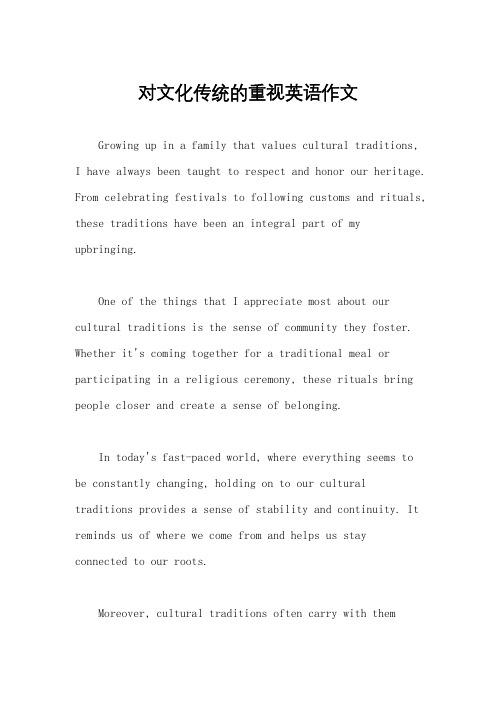
对文化传统的重视英语作文Growing up in a family that values cultural traditions, I have always been taught to respect and honor our heritage. From celebrating festivals to following customs and rituals, these traditions have been an integral part of my upbringing.One of the things that I appreciate most about our cultural traditions is the sense of community they foster. Whether it's coming together for a traditional meal or participating in a religious ceremony, these rituals bring people closer and create a sense of belonging.In today's fast-paced world, where everything seems to be constantly changing, holding on to our culturaltraditions provides a sense of stability and continuity. It reminds us of where we come from and helps us stay connected to our roots.Moreover, cultural traditions often carry with themvaluable lessons and wisdom that have been passed down through generations. They teach us about our history, values, and beliefs, shaping our identity and guiding us in our daily lives.In a globalized world where cultures are increasingly blending and evolving, it is important to preserve and promote our cultural traditions. They not only enrich our lives but also contribute to the diversity and richness of the global cultural landscape.。
大学进阶英语2第一单元作文
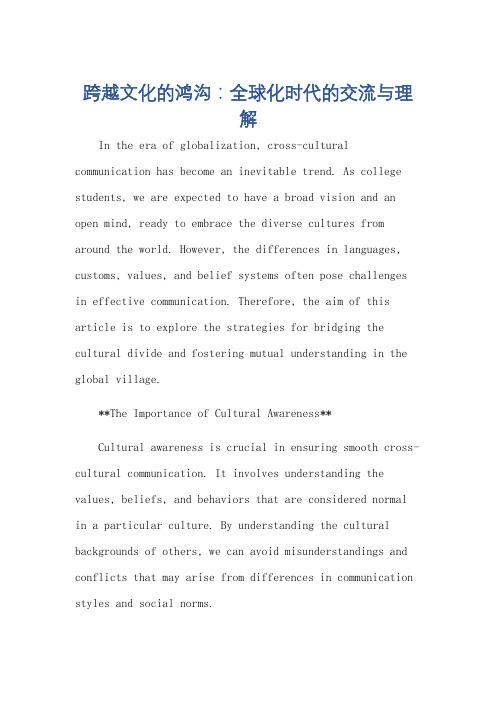
跨越文化的鸿沟:全球化时代的交流与理解In the era of globalization, cross-cultural communication has become an inevitable trend. As college students, we are expected to have a broad vision and an open mind, ready to embrace the diverse cultures from around the world. However, the differences in languages, customs, values, and belief systems often pose challenges in effective communication. Therefore, the aim of this article is to explore the strategies for bridging the cultural divide and fostering mutual understanding in the global village.**The Importance of Cultural Awareness**Cultural awareness is crucial in ensuring smooth cross-cultural communication. It involves understanding the values, beliefs, and behaviors that are considered normal in a particular culture. By understanding the cultural backgrounds of others, we can avoid misunderstandings and conflicts that may arise from differences in communication styles and social norms.**The Role of Language in Cross-Cultural Communication**Language is a powerful tool in cross-cultural communication. However, it can also be a barrier if not used correctly. It is essential to have a basic understanding of the language spoken by the other party to ensure effective communication. Additionally, one should be aware of the nuances and idioms that may vary across cultures. For instance, a phrase that is considered humorous in one culture may be offensive in another. Therefore, it is important to use language sensitively and avoid making assumptions about the other party's cultural background.**The Power of Nonverbal Communication**Nonverbal communication, such as facial expressions, body language, and tone of voice, plays a crucial role in cross-cultural communication. Often, these cues can convey messages that words cannot express. However, they can also lead to misunderstandings if not interpreted correctly. For instance, a gesture that is considered respectful in one culture may be considered disrespectful in another.Therefore, it is important to be aware of the nonverbal cues used in different cultures and interpret them accurately.**Strategies for Bridging the Cultural Divide**To bridge the cultural divide, it is essential to adopt a positive and inclusive attitude towards other cultures. Here are some strategies that can help foster mutual understanding:1. **Openness and Curiosity**: Be open to learning about other cultures and show curiosity about their values, beliefs, and traditions. This will help you gain a deeper understanding of their perspective and ways of communication.2. **Active Listening**: Listen actively to understand the other party's perspective instead of waiting to respond. This will help you build trust and show respect for their views.3. **Respect for Differences**: Acknowledge and respect the differences in communication styles and social norms across cultures. Avoid judging or criticizing the other party's culture.4. **Clarification and Confirmation**: Seek clarification if you are unsure about a message or cultural practice. Confirm yourunderstanding with the other party to ensure that there are no misunderstandings. 5. **Cultural Adaptation**: Be flexible and willing to adapt your communication style to fit the context and norms of the other culture. This will help you establish better relationships and foster mutual understanding.In conclusion, bridging the cultural divide requires effort and commitment from both parties involved in cross-cultural communication. By fostering cultural awareness, understanding the role of language, and mastering the art of nonverbal communication, we can overcome the challenges posed by cultural differences and build meaningful relationships with people from diverse backgrounds. In the globalized world, such skills are crucial for effective communication and mutual understanding.。
对待文化差异英语作文

对待文化差异英语作文When encountering cultural differences, it's important to approach them with an open mind and a willingness to learn. Here's how one might address cultural differences in an English composition:In our increasingly globalized world, cultural differences are an inevitable part of life. As we interact with people from various backgrounds, it is crucial to understand and respect these differences. This essay will explore the significance of cultural diversity and offer strategies for embracing it.Understanding Cultural DifferencesCultural differences arise from a variety of factors, including history, geography, religion, and social norms. Each culture has its unique set of values and traditions that shape its people's behavior and beliefs. Understanding these differences is the first step towards embracing them. It involves educating oneself about the customs, language, and social etiquette of other cultures.Respecting Cultural DiversityRespect is the cornerstone of any interaction with people from different cultures. It means acknowledging and valuing the beliefs and practices of others, even if they differ from our own. Respect can be shown through simple gestures such as using polite language, dressing appropriately, and being mindful of cultural taboos.Communication and LearningEffective communication is key to navigating cultural differences. It involves active listening and expressing oneself clearly and respectfully. When misunderstandings occur, which they inevitably will, it's important to seek clarification and learn from the experience. This can lead to a deeper understanding and appreciation of the other culture.Adapting to Cultural DifferencesAdaptability is a valuable skill when dealing with cultural differences. It involves being flexible and willing to adjust one's behavior to fit the cultural context. For example, in some cultures, direct eye contact is considered respectful, while in others it might be seen as confrontational. Adapting to such nuances can help foster positive relationships.Celebrating Cultural DiversityRather than viewing cultural differences as barriers, we should celebrate them as opportunities for growth and enrichment. Cultural diversity can lead to innovative ideas, broadened perspectives, and a richer global community.Embracing different cultures can also enhance our own cultural identity by providing new insights and experiences.ConclusionIn conclusion, cultural differences are an integral part of our global society. By understanding, respecting, communicating, adapting, and celebrating these differences, we can build bridges between cultures and create a more harmonious world. It is through embracing diversity that we can truly appreciate the beauty of our interconnected humanity.This composition provides a structured approach to dealing with cultural differences, emphasizing the importance of education, respect, communication, adaptability, and celebration.。
文化交流与理解高中英语作文
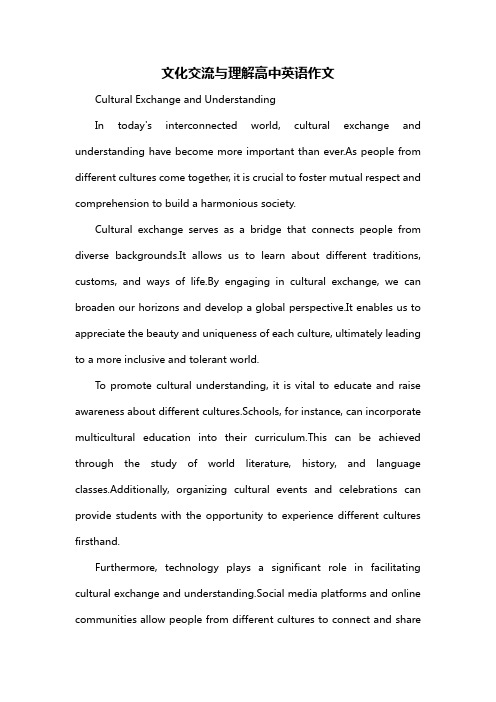
文化交流与理解高中英语作文Cultural Exchange and UnderstandingIn today's interconnected world, cultural exchange and understanding have become more important than ever.As people from different cultures come together, it is crucial to foster mutual respect and comprehension to build a harmonious society.Cultural exchange serves as a bridge that connects people from diverse backgrounds.It allows us to learn about different traditions, customs, and ways of life.By engaging in cultural exchange, we can broaden our horizons and develop a global perspective.It enables us to appreciate the beauty and uniqueness of each culture, ultimately leading to a more inclusive and tolerant world.To promote cultural understanding, it is vital to educate and raise awareness about different cultures.Schools, for instance, can incorporate multicultural education into their curriculum.This can be achieved through the study of world literature, history, and language classes.Additionally, organizing cultural events and celebrations can provide students with the opportunity to experience different cultures firsthand.Furthermore, technology plays a significant role in facilitating cultural exchange and understanding.Social media platforms and online communities allow people from different cultures to connect and sharetheir experiences.Virtual exchange programs, where students from different countries interact through video calls, enable them to learn from one another and gain a deeper understanding of each other's cultures.However, cultural exchange and understanding are not merely about learning about different cultures; it also involves embracing diversity and challenging stereotypes.It is essential to break away from ethnocentric viewpoints and recognize the value of cultural diversity.By doing so, we can foster a sense of unity and global citizenship among individuals from different backgrounds.In conclusion, cultural exchange and understanding are vital for creating a more inclusive and tolerant world.By educating ourselves about different cultures, leveraging technology, and challenging stereotypes, we can build bridges of understanding and promote harmony among diverse communities.Embracing cultural diversity enriches our own lives and contributes to a more peaceful and interconnected world.。
增加对传统文化的重视英语作文
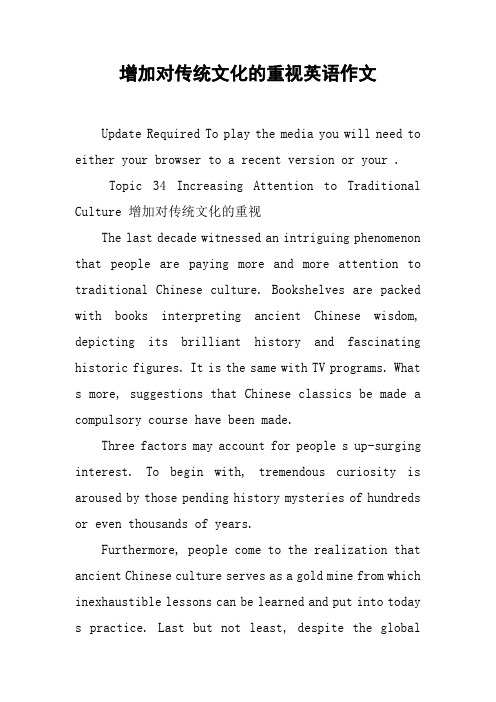
增加对传统文化的重视英语作文Update Required To play the media you will need to either your browser to a recent version or your .Topic 34 Increasing Attention to Traditional Culture 增加对传统文化的重视The last decade witnessed an intriguing phenomenon that people are paying more and more attention to traditional Chinese culture. Bookshelves are packed with books interpreting ancient Chinese wisdom, depicting its brilliant history and fascinating historic figures. It is the same with TV programs. What s more, suggestions that Chinese classics be made a compulsory course have been made.Three factors may account for people s up-surging interest. To begin with, tremendous curiosity is aroused by those pending history mysteries of hundreds or even thousands of years.Furthermore, people come to the realization that ancient Chinese culture serves as a gold mine from which inexhaustible lessons can be learned and put into today s practice. Last but not least, despite the globaldominance of western culture, our ethnic cultural pride has significantly increased.In my opinion, without any doubt, it is of positive significance that we pay more attention to our traditional culture. Not only can we derive pleasure from solving the mysteries in history, but we can learn a great deal from our ancestors wisdom.。
- 1、下载文档前请自行甄别文档内容的完整性,平台不提供额外的编辑、内容补充、找答案等附加服务。
- 2、"仅部分预览"的文档,不可在线预览部分如存在完整性等问题,可反馈申请退款(可完整预览的文档不适用该条件!)。
- 3、如文档侵犯您的权益,请联系客服反馈,我们会尽快为您处理(人工客服工作时间:9:00-18:30)。
Towards a Cultural Ontology for Interorganizational Knowledge ProcessesEl-Sayed Abou-ZeidDepartment of Decision Sciences and MISJohn Molson School of BusinessConcordia University1455, de Maisonneuve Blvd. W.Montreal, Canada, H3G 1M8Email: elsayed@jmsb.concordia.caAbstractThe explication of national-specific and organizational-specific value systems of the firms involved in interorganizational knowledge management processes is the necessary condition for their success. The term cultural ontology is introduced to refer to such explication. Based on an inter-organizational knowledge-manipulating process model and on framework for studying the cultural influences on knowledge transfer process, the elements of cultural ontology are specified. The cultural ontology specification document includes its domain, purpose, level of formality, scope, possible sources of knowledge, competency questions and the possible reusable ontologies.1. IntroductionGlobalization, the ever-growing knowledge of customers and competitors and the increased demands for personalization in products and services are but some of the factors that make managing knowledge across national borders of crucial importance in sustaining and enhancing firms’ competitiveness (e.g., [41]. However, since no single firm has the full range of knowledge and expertise needed for timely and cost-effective product and service innovation, firms are increasingly setting up various formsof cross-border collaborative arrangement, such as joint ventures, strategic alliances and multinational corporations, in order to access knowledge and capabilities unavailable internally [15].Knowledge, however, is socially produced and reproduced, and its manipulating processes, i.e., generation, mobilization and application, are constrained by the social and cultural contexts in which they are embedded. In fact, research on knowledge management initiatives has shown that knowledge and culture are inextricably linked in organizations, and has recognized the role of organizational culture as a major barrier to leveraging knowledge [14, 18, 25]. Therefore, the effectiveness of inter-organizational knowledge processes will be affected by the degree of national [3] and organizational cultural heterogeneity between the firms involved.Schein (1996) defined organizational culture as “a set of tacit assumptions about how the world is and ought to be that a group of people share and that determines their perceptions, thoughts, feelings, and, to some extent their overt behavior” [34] . Therefore, organizational culture can be viewed as the collective tacit knowledge members of the organization use to generate and interpret social behavior. According to Schein (1985), this tacit knowledge comprises values, beliefs and basic underlying assumptions. In the same vein, Hofstede [21] defines culture as “the collective programming of the mind which distinguishes the members of one group or category from those of another.” Therefore, making such tacit knowledge explicit and communicable is the ethical responsibility of management in international companies [35]. Such explication can support interorganizational knowledge processes in different ways, such as by specifying explicitly the similarities and differences in the value systems of the firms involved, building a shared vocabulary, and selecting the most appropriate knowledge transfer mode.The means of such explication is the development of cultural ontology. Ontology, from the perspective of theAI community, is “an explicit specification of shared conceptualization” [16], italics added) that aims to facilitate communication between people and organizations and inter-operability between systems and systems engineering [37]. In this context, “conceptualization is an abstract, simplified view of the world that we wish to represent for some purpose” [16]. It involves a system of concepts in terms of which the corresponding universe of discourse is divided into things, processes and relations in different sorts of ways. In the case of cultural ontology such conceptualization, which reveals in the ways one behaves when engaging in day-to-day activities, deals with the system of values adopted by members of the organization.The main objective of this work is twofold. The first is to develop a framework for specifying a cultural ontology in the context of interorganizational knowledge management (KM). The second is to use this framework in defining an ontology requirements specification document and its preliminary conceptual model. The remainder of the paperis organized as follows. After introducing the elements of an inter-organizational knowledge process model, its underlying cultural dimensions are discussed. Next, the definition of cultural ontology is introduced, together withits preliminary conceptual model, and the ways in which the proposed cultural ontology can support inter-organizational knowledge processes are discussed. The paper then concludes by discussing possible areas of future research.2. Inter-organizational knowledge processes and their cultural dimensions2.1. An inter-organizational knowledge process modelBased on the literature review (e.g., [11, 22, 28, 29, 42] and on analysis of several KM initiatives (e.g., [6, 8, 9] K-manipulation processes can be classified into three main categories, i.e., K-generation, K-mobilization and K- application. The first category, K-generation processes, includes all processes by which new knowledge is generated within the organization. There are several typesof knowledge generation, namely: Acquisition where the new knowledge is acquired from external sources; Externalization where the convertible tacit knowledge of the members of the involved firms is conceptualized and articulated; Discovery where the knowledge hidden in the data sources of the involved firms (e.g., databases, data warehouses) is discovered; Synthesis where the new knowledge is generated either by integrating the newly generated and validated knowledge with the existing knowledge, or by combing the existing knowledge; and Production (creation) where the new knowledge is produced by interacting with the things in cognitive domains of the enterprise [5]. An example of this is the formation of international R&D units [40].The second category, K-mobilization processes, includes all processes that aim at increasing the visibility or accessibility of existing or newly generated knowledge by sharing it or transferring it from one bearer (the knowledge provider, owner or source) to another (the knowledge seeker or target) through space or time. The knowledge bearer could be artifact, such as technical documents or best practice databases, or human, such as experts in a certain domain.The last category, K-application processes, includes the processes by which knowledge is embodied in various forms. For example, knowledge can be used to develop a new product/service/business process or to improve existing ones. Associated with these processes are the processes of K-evaluation, which include all the activities that aim at justifying and measuring the business value of the knowledge [39]. The K-evaluation process may initiate a K-identification process which includes all the activities that develop the awareness of the need to create new K-things or to update existing ones.2.2. Cultural dimensions of inter-organizational knowledge processesIn order to study the cultural dimensions of inter-organizational knowledge processes a modified version of De Long and Fahey’s (2000) framework for studying cultural barriers to knowledge management within an organization will be used. According to this framework, there are four areas in which culture influences the behaviors central to knowledge and its manipulating processes. First, culture shapes assumptions about which knowledge is worth generating and how, in what form, and for what purpose [41], i.e., knowledge (K-) valuation. Second, it defines knowledge (K-) structure, that is, how knowledge and skills are distributed and utilized within the firm. Third, it creates the organizational context of social interactions for knowledge generation, mobilization and application, i.e., knowledge (K-) contextuality. Finally, culture shapes the decision-making processes by which new knowledge is translated into action, i.e., knowledge (K-) actualization.While the De Long & Fahey’s framework is useful in identifying the different areas in which national and organizational cultures influence knowledge-oriented behaviors, it does not indicate the mechanisms by which each of the cultures, which will be treated as two distinct constructs each has its distinct contents and effects (e.g., [4, 13, 36], realize their influences. To make suchmechanisms explicit, Schein’s model of organization culture [33] will be used since it can be applied to both national and organizational cultures [36]. According to this model, culture exists at three levels of abstraction: assumptions, values and artifacts. On the surface are artefacts; underneath artifacts lie values, and at the core are the basic assumptions. Basic assumptions represent taken-for-granted beliefs that people share regarding such things as human nature and social relationships, and among social institutions and their environment. Values represent standards or criteria for selecting from alternatives and standards that guide ongoing activities. They define appropriate end-states (terminal values) and the means (instrumental values) of achieving those ends [32]. Artifacts, which are the most concrete components of culture, include physical evidence such as architecture, explicit communicators like mission statements, and implicit communicators like rites and rituals. However, as values are both more accessible than assumptions and more reliable than artifacts, they can be reliably used to characterize organizational culture [23].Drawing on the previous discussion and on the interorganizational knowledge process model, the national-specific and organizational-specific values relevant to the interorganizational K-manipulating processes are analyzed along two dimensions. The first is the main components of interorganizational knowledge process, i.e., K-generation, K-mobilization and K-application. The second dimension is the area of influence, i.e., K-valuation, K-structure, K-contextuality and K-actualization. Furthermore, these values can be classified into two main groups. The first group includes the national-specific and organizational-specific terminal values of involved firms with regard to topics, types, forms and outcomes of knowledge to be generated, shared or acquired, i.e., those that affect K-valuation. Examples of national-specific values are complementarity (either/or vs. both/and), time-orientation (long-term vs. short-term) [41] and abstractive vs. associative [24].The second group includes the national-specific and organizational-specific instrumental values that affect K-structure, K-contextuality and K-actualization. With regard to K-structure, national-specific values such as power distance and uncertainty avoidance affect K-mobilization within and between the involved firms [41]. With regard to organizational-specific values, one can distinguish two sets. The first set includes values that underlie highly diffused and group-based K-structure, such as job rotation, group learning, reduced social distance between different categories of the workforce and collective ownership of knowledge. The second set includes those values that underlie task specific and individual-based K-structures, such as job differentiation, individual specialization and individual ownership of knowledge [7, 25]. The first set of values affects the K-inflow, as these values support sharing the newly acquired knowledge between the individuals and organizational entities of the target firm. Moreover, the value of “collective ownership of knowledge” of the target firm determines which transfer mechanisms are to be used. In addition, “trust” is of crucial importance on both the K-outflow and K-inflow sides [7, 31].The values affecting K-contextuality can be assessed on at least three dimensions [7]: vertical interactions, horizontal interactions, and special behaviours that promote knowledge mobilization and application within and between the involved firms. The first dimension, vertical interactions, deals with values that are relevant to knowledge sharing between different organizational levels such as power distance, verticalness on the national level [3], the acceptability of discussing sensitive topics (openness), and approachability of senior management atthe organizational level. The second dimension, horizontal interactions, deals with the set of values that are needed to leverage knowledge sharing among individuals and organizational entities at the same level in the involved firms. This set includes horizontalness at the national level [3], team-oriented values such as team orientation, collaboration, cooperation, group harmony, consensus/agreement, participative decision-making and team accountability on the organizational level. The final dimension deals with the set of values that “shape the context of social interaction to support knowledge sharing and use” [7]. For example, in the case of K-mobilization between two firms, this set includes willingness to share knowledge with other firms on the K-outflow side, and willingness to learn from other firms on the K-inflow side [19]. This set also includes supportive values such as respect for the individual and professional growth opportunities [23], and K-re-use.Finally, values that support K-actualization are mainly innovation values which include innovation, willingnessto experiment, leading-edge technologies, creative problem-solving and tolerance for mistake [23]. Tables (1) and (2) show examples of the national-specific and organizational-specific values relevant to the interorganizational K-manipulating processes.Table (1): Examples of the national-specific values relevant to the interorganizational K-manipulatingprocesses.K-Manipulating ProcessGeneration Mobilization ApplicationK-ValuationType Either/or vs. both/and [41].Abstractive vs. associative,Tacitness vs. explicitness[24].Form Integration vs. invention[41].Outcome Time orientation [41]. Time orientation [41].K-StructurePower distance [41].K-ContextualityVertical Interactions Power distance [41],Verticalness [3].Horizontal Interactions Individualism/Collectivism[41], Horizontalness [3].Special Behavior Uncertainty avoidance [41].K-ActualizationTimeorientation[41].Table (2): Examples of the organizational-specific values relevant to the interorganizational K-manipulating processes [2].K-Manipulating ProcessGeneration Mobilization ApplicationK-ValuationValues regarding the topics, type and form of knowledge to be generated.Values regarding the topics, type and form of knowledge to be shared.K-StructureCollective ownership, Grouplearning,Job rotation,Trust, Integration betweenfunctions.K-ContextualityVertical Interactions Openness, Approachability,Accessibility.Horizontal Interactions Trust , Team-orientedvalues.Team-oriented values.Special Behavior Willingness to shareknowledge with and to learnfrom other firms,Supportiveness values,K-re-use.K-ActualizationInnovationvalues.3. Toward cultural ontologyOne of the main objectives of developing ontologies is to facilitate “communication between people with different needs and viewpoints arising from their differing contexts” [37]. This objective is achieved by developinga unifying conceptual framework that acts as a lingua franca between the different parties involved in the communication activity. In the case of inter-organizational knowledge management, the different parties are the firms involved in K-manipulating processes. Since each firm has its own culture, which is influenced by the national culture in which the firm is embedded [27], and this culture is revealed in its distinct value system, the explication of the national-specific and organizational-specific value systems of the involved firms is the prerequisite for the creation of the mutual and shared understanding necessary for effective interorganizational knowledge management. Such explication of the value systems of firms is what we call cultural ontology.The first step in building a cultural ontology is the identification of its development activities. METHONTOLOGY methodology has been chosen as it provides explicit and detailed guidelines of ontology conceptualization activity i.e., an activity that specifies a conceptualization at the knowledge level and that is independent of formal languages and implementation environments [2, 10]. This activity is important for validating the ontology at the knowledge level by providing intermediate representations that can be evaluated by domain experts and human end-users [10]. According to this methodology, there are four main ontology development-oriented activities, i.e., specification, conceptualization, formalization and implementation. The goal of the specification activity isto produce requirements specification document for the ontology. Such a document includes items such as the domain, purpose, level of formality, sources of knowledge, and competency questions of the ontology. In conceptualization activity, the domain knowledge will be structured in conceptual models that describe the problem and its solution in terms of the domain vocabulary identified in the ontology specification activity. Since the purpose of this work is not to develop fully a cultural ontology but rather to identify its elements and the roles it can play in interorganizational knowledge management, we will focus on the first ontology development activity, i.e., its specification. However, a preliminary set of IRs will be introduced.As the main concerns of the intended cultural ontology are those national-specific and organizational-specific values with respect to knowledge in general and its manipulating processes in particular, and as this knowledge is associated with something in a firm’s domain of interest, three concepts will be introduced, namely, business (B-) thing, knowledge (K-) thing and knowledge-manipulating (K-) process [1]. B-thing is any thing towards which thought or action is directed or is communicated by the members of the firm, e.g., business outcome (products or services), business process and business rule. Each B-thing is associated with certain knowledge that is needed to deal with it or to act upon it. For example, STEP (The Standard for the Exchange of Product Model Data) data architecture has recognized three categories of knowledge to be associated with a product, i.e., classification, marketing and technical [12]. This knowledge is characterized in terms of one or more knowledge thing (K-thing). A K-thing describes the knowledge about the knowledge associated with a B-thing, i.e., the meta-knowledge. Such a distinction between B-things and K-things is important, since the knowledge associated with a B-thing is in constant change and is context-dependent. For example, the knowledge required to manufacture a certain product may change because of the introduction of new technology or the emergence of new marketing demands. Finally, the K-manipulating process is the process that changes the state of a K-thing. For example, during its life cycle K-things can exist in different states that correspond to the states of the knowledge associated with B-things, e.g., “Being identified, “Being created”, “Being acquired”, “Being synthesized”, “Being externalized”, “Being preserved”, “Being actualized”. The state transitions of a K-thing are caused by performing one or more K-manipulating process [1]. Moreover, each K-thing and each K-process is associated with a set of values that influences the behaviors central to them.These concepts, together with the cultural dimensions of the inter-organizational K-manipulating processes previously discussed, are considered as the cultural ontology specification activity which yields the specification document shown in Figure (1).Domain Organizational culturePurpose Ontology about organizational-specific values and relevant national-specific values to be used when information about values relevant to the inter-organizational knowledge processes is requiredin evaluating the similarities and differences in the value systems of the firms involved.Level of Formality Semi-formal.Scope List of national-specific and organizational-specific values that are relevant to inter-organizational knowledge manipulating processes, such as power distance, uncertaintyavoidance, collective ownership, trust, approachability, accessibility, team oriented values,willingness to share knowledge and willingness to learn.Properties that characterize values such as role and relative importance.List of related concepts such as firm, B-thing, K-thing and K-manipulating process.Properties that characterize the related concepts (for example Table (2)).Sources of Knowledge Organizational documents (e.g., mission statement, corporate plan). Organizational value survey, Organizational Culture Profile.KM case studies.……………………Examples of Cultural Ontology’s Competency Questions CQ.1. What is the national-specific value system of firm X with regard to the type/form/outcome of the knowledge about a specific B-thing?CQ.2. What is the organizational-specific terminal value system of firm X with regard to the type/form/outcome of the knowledge about a specific B-thing?CQ.3. What is the organizational-specific instrumental value system of firm X with regard to generating knowledge about a specific B-thing?CQ.4. What is the organizational-specific instrumental value system of firm X with regard to mobilizing knowledge about a specific B-thing?CQ.5. What is the organizational-specific instrumental value system of firm X with regard to applying knowledge about a specific B-thing?CQ.6. What is the organizational-specific instrumental value system of firm X with regard to breadth of the transferred knowledge dissemination?Potentially Reusable OntologiesTOVE Ontology [17] and Enterprise Ontology [38] as potential ontologies for representing B-things.Figure (1): Cultural Ontology Requirements Specification DocumentAccording to METHONTOLOGY methodology, the ontology’s conceptualization activity includes four main steps, i.e., building a glossary of terms, building concept-classification trees (taxonomies), building binary-relations diagrams, and developing intermediate representations (IRs) for each concept-classification tree [10]. IRs include items such as concept dictionary, which describes and gathers all the useful and potentially usable domain concepts, their meanings, attributes, instances, etc.; tables of instance attributes, which provide information about the attribute or about its values at the instance; tables of class attributes, to describe the concept itself, not its instances; tables of constants, used to specify information related to the domains of knowledge that always take the same value; tables of instances, which define instances; and attributes classification trees, to graphically display attributes and constants related in the inference sequence of the root attributes, as well as the sequence of formulas or rules to be executed to infer such attributes. Since the full conceptualization of organizational cultural ontology is beyond the scope of this paper, examples of the outcomes of only the first three conceptualization activities, i.e., building a glossaryof terms, building concept-classification trees (taxonomies), and building binary-relations diagrams will be presented. Table (3) shows examples of the terms of a cultural ontology. Figure (2) shows examples of concept-classification trees using the subclass-of relations. Finally, figure (3) shows a simple UML diagram that depicts the relationships between concepts of the same or different taxonomies.Table (3): Glossary of some terms of the cultural ontology Name of the Concept DescriptionNational-specific Value A common value shared by people within a given country and can be used to distinguishone country’s culture from another such as power distance, uncertainty avoidance andindividualism (e.g., [13, 20]).Organizational-specific Value “An enduring belief that a specific mode of conduct or end-state of existence ispersonally or socially preferable to an opposite or converse mode of conduct or end-stateof existence” [32].Terminal Value A desired goal that an organization seeks to achieve, such as excellence, stability,profitability, or quality.Instrumental Value A desired mode of behavior that an organization wants its members to observe, such asbeing hard working, being conservative, or being honest.K-oriented Terminal ValueA desired k-oriented goal that an organization seeks to achieve such as k-accessibility. K-oriented Instrumental Value A desired mode of behavior that an organization wants its members to observe, such as trust, collaboration and willingness to learn.Value System “An enduring organization of beliefs concerning preferable modes of conduct or end-states of existence along a continuum of relative importance” [32].B-Thing Any thing toward which thought or action is directed or is communicated by themembers of the firm, e.g., business outcome (products or services), business process,business rule, consumers, suppliers, competitors, and partners.K-Thing A description of the knowledge about the knowledge associated with a B-thing, i.e., themeta-knowledge.K-Manipulating Process Any process that changes the state of a K-thing, e.g., K-externalization, K-socialization(human-human K-mobilization and K-identification.Inter-organizational K-Manipulating ProcessAny K-manipulating process that involves at least two firms.Figure (2): Examples of cultural ontology concept classification trees (taxonomies)Figure (3): A UML binary-relations diagram4. The Role of cultural ontology in inter-organizational knowledge processes and value creation: A general viewInter-organizational knowledge processes can be viewed as a collaboration process in which two or two or more organizations with complementary knowledge interact to create shared understanding that none had previously possessed or could have come to on their own. Therefore, effective collaboration has to take place in order for organizational knowledge of involved firms to be effectively used to create business value. One of the conditions for effective collaboration is the existence of a shared space where different perspectives may be shared and shared understandings generated [30].One of the main objectives of developing a cultural ontology is the creation of explicit mutual and shared understanding of the value systems of the firms involved in K-manipulating processes. Such explication is essential for identifying the degree of congruence and complementarity of the firms’ value systems. For example, the congruence between value systems regarding K-structure (know-how) and those regarding K-actualization (know-why) affects the effectiveness of the overall K-transfer process [26]. Moreover, the “complementarity” of special behavior values, i.e., willingness to share knowledge with other firms on the source firm side and willingness to learn from other firms on the target firm side, is essential for the knowledge transfer process to be successful. Figure (4) shows the relation between the cultural ontology competency questions and the different elements of the inter-organizational knowledge processes.5. ConclusionA framework for specifying and conceptualizing an organizational cultural ontology, as characterized by national-specific and organizational-specific value systems, in relation to inter-organizational knowledge transfer is developed. This framework is based on an inter-organizational knowledge-manipulating process model and on [7] framework for studying cultural influences on knowledge processes.As the shared and mutual understanding of each other’s value system is necessary for performing effective interorganizational K-manipulating processes, the explication of the involved firms value systems becomes inevitable. The term cultural ontology is introduced to refer to such explication. Based on this framework, the elements of cultural ontology are specified. The cultural ontology specification document includes its domain, purpose, level of formality, scope, possible sources of knowledge, competency questions and the possible reusable ontologies. Moreover, the competency questions are grouped in such a way that each group includes thosere la te d to。
